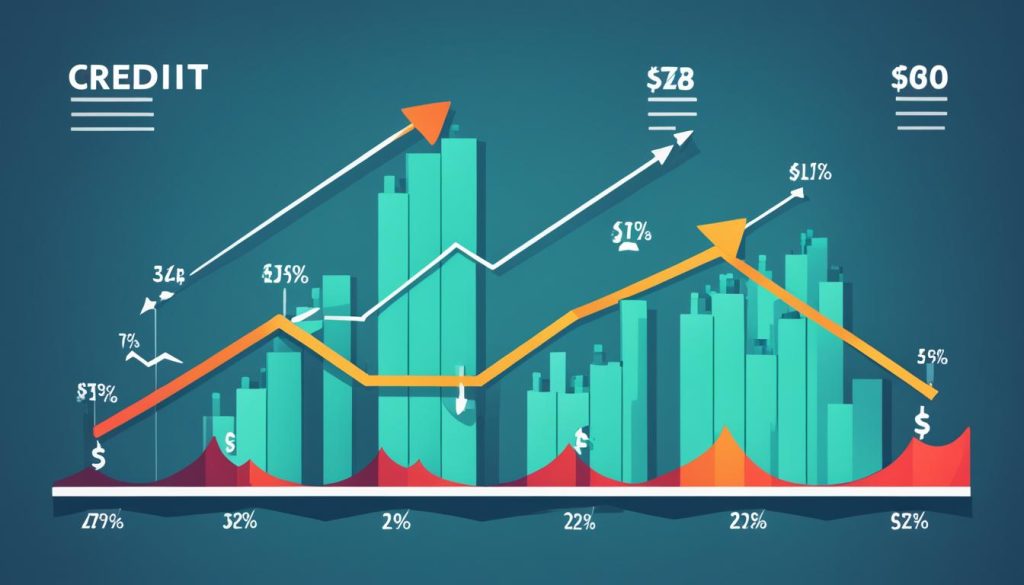Creating a strong credit risk management plan is key for banks and lenders. It helps reduce risks, increase profits, and boost productivity. By learning the best ways to manage credit risk, you can make a solid plan. This plan helps your organization and customers.
In today’s fast-changing financial world, 76% of traditional banks are worried about fintech’s rise1. A good credit risk management plan gives your business the security and stability it needs to succeed.
At the core of credit risk management is checking if a borrower can pay back a loan. This means looking at the “Five Cs of Credit” – character, capacity, capital, collateral, and conditions1. Also, charging higher interest rates to borrowers with moderate risk is a smart way to manage credit risk.
The financial industry is always changing. Using data-driven methods and new technologies can make your credit risk management better. Tools like automation1 and machine learning can help predict risks more accurately1. These tools can change how you handle credit risk.
Key Takeaways
- Effective credit risk management is crucial for financial stability, profitability, and customer satisfaction.
- The “Five Cs of Credit” – character, capacity, capital, collateral, and conditions – are key factors in assessing a borrower’s creditworthiness.
- Leveraging data analytics and emerging technologies, such as machine learning and AI, can enhance credit risk modeling and decision-making.
- Proactive credit risk analysis helps identify patterns in unpaid invoices, manage cash flow, and make strategic decisions for accounts receivable management.
- Streamlining credit risk management processes through automation and digitalization can improve efficiency and reduce operational costs.
Understanding the Credit Risk Management Process
Effective credit risk management is key for banks to keep their loans safe and healthy. It’s a detailed way to check if borrowers can pay back loans. This process looks at how likely a customer might not pay back before giving them credit2. It helps banks make smart choices and avoid big losses2.
What is the Credit Risk Management Process?
This process has steps to see if a borrower is good with money. It looks at their credit history, income, debts, and more to see if they might default2. By checking credit reports and debt-to-income ratios, lenders can understand if a borrower is likely to pay on time2.
Why is Credit Risk Management Important?
It’s vital for banks to lend to people who are likely to pay back. If people don’t pay, banks lose money, even with collateral2. Banks use better analysis to spot risks early and act on them2. For clients from other countries, things like currency changes and economic issues matter a lot2.
Good credit risk management lets banks make smart choices and keep their cash flow steady2. Using market trends and economic signs in analysis makes credit risk assessments more accurate2.
“Striking a balance in credit risk decisions is crucial to maximizing a company’s bottom line.”2
With strong credit risk management, banks can lower risks, avoid big losses from sudden defaults, and keep their loans profitable2.
Credit Risk Trends: Leveraging Data and Technology
The lending world has changed a lot lately, especially after the pandemic. Now, more people need quick loans for their financial needs. This makes managing credit risk very important for banks3. To keep up, banks are using new tools like data analytics and machine learning to check credit risk better.
Machine learning is really good at checking credit risk, doing 10 to 15 percent better than old methods3. A survey in September 2021 showed that about 80 percent of businesses trust AI and cloud-based systems for credit risk3. These tools help banks make better, faster decisions, which lowers risk and increases profits.
Using machine learning with different kinds of data, like not just bank info but also things like rent payments, has changed the game3. This way, banks get a fuller picture of someone’s finances, making their risk assessments more accurate. This leads to lending to more people, making credit more accessible.
But, using these new technologies is not without its challenges. It’s important to make sure these systems don’t show bias and are clear about how they work3. Banks also need to be able to quickly update their risk models to keep up with changes in the market and how people behave3.
The future of managing credit risk is all about combining data analytics, machine learning, and automation4. A digital-first lending platform with ML can automate the loan process, handle more loans, make customers happier, and free up resources for growth3. As the credit industry keeps changing, banks that use these new technologies will stay ahead.
Now, we’re seeing more use of data like utility bills and streaming service payments for credit risk analysis5. This lets banks lend to more people, making credit more inclusive5. But, it also means finding reliable risk signals is harder, as there’s more data and complex decisions to make5.
As AI and machine learning get more common in credit risk, there’s a risk of bias in these systems5. To avoid this, banks need to focus on making algorithms that are clear and fair, following the rules4.
Changes in how people think about money are also affecting the credit industry, with the U.S. getting ready for open banking5. People are okay with banks looking at their full financial picture, making the market more open5. Technology, especially AI and machine learning, is key in changing how credit analysis works, helping banks make smarter decisions5.
| Credit Risk Trends | Key Insights |
|---|---|
| Machine Learning in Credit Risk Evaluation | ML models have shown to outperform traditional models by 10-15%3 |
| Adoption of AI and Advanced Analytics | 80% of businesses are confident in AI and cloud-based credit risk decisioning, with 70% frequently discussing the use of advanced analytics and AI3 |
| Leveraging Alternative Data Sources | Alternative data is enabling lenders to extend credit products to more people and paving the way for financial inclusion5 |
| Bias Mitigation in Credit Risk Models | Ensuring the removal of biases and maintaining model explainability is crucial for ethical and regulatory reasons3 |
| Agile Credit Risk Models | Organizations must have agile credit risk models that can be quickly adjusted to respond to unexpected events and shifts in consumer behavior3 |
| Automation in Lending Processes | A digital-first lending platform combined with ML models can help automate loan underwriting, manage increased loan volumes, and enhance customer satisfaction3 |
Best Practices for Managing Credit Risks
Managing credit risks well is key for banks to make more money and lower risks. By using top strategies, you can make your credit portfolio stronger. This helps you deal with the changing credit world6.
Understand the Five Cs of Credit
First, look at the “Five Cs of Credit” – Character, Capacity, Capital, Collateral, and Conditions. This helps you see if someone is good for a loan. It makes your lending choices better and lowers the chance of defaults7.
Validate Scorecard Models Regularly
Make sure your scorecard models are up to date. Markets and borrower habits change often. You need to check your systems and adjust as needed6.
Leverage Dynamic Data and AI/ML
Use dynamic data and new tech like AI and machine learning to improve managing credit risks. These tools spot risks fast, send early warnings, and help make quicker decisions67.
Strengthen Governance and Implementation
Create a strong governance system for quicker decisions and better risk management. Having plans ready helps you react fast to market changes and customer needs6.

Successful credit risk management means always checking data, updating models, and using the latest tech. By following these best practices, you can handle the changing credit world well. This keeps your credit portfolio healthy and profitable78.
Effective Methods for Managing Credit Risks
Managing credit risks well is key for your financial institution’s success. One important method is risk-based pricing. You charge more interest to those seen as moderate credit risks9. This approach helps cover potential losses and encourages customers to keep their credit good.
Regular MIS reports are also vital. They let you watch your borrowers’ finances and repayment habits closely. This way, you can spot and fix problems early10.
Stress testing your credit portfolio is also smart. It lets you see how tough economic times could affect your loans. This helps you get ready for hard times9.
A strong credit risk management framework is at the core of good risk management. It includes detailed credit checks, spreading out credit risks, and always watching your borrowers’ credit status9. With this framework, you can better spot, judge, and reduce credit risks.
| Effective Methods for Managing Credit Risks | Key Benefits |
|---|---|
| Risk-based Pricing | Offsets potential losses and incentivizes good credit standing9 |
| Periodic MIS Reporting | Enables early identification of potential issues and proactive risk mitigation10 |
| Stress Testing | Prepares the institution for adverse economic conditions9 |
| Comprehensive Credit Risk Management Framework | Enhances the ability to identify, assess, and mitigate credit risks9 |
These methods work well but have their challenges. Bad data management, lacking infrastructure, and poor reports can slow down a good credit risk system10. By fixing these issues and improving your risk management, you can make your institution stronger and keep your loans healthy.

“Effective credit risk management is not just a regulatory requirement, but a strategic imperative for financial institutions that want to thrive in today’s dynamic market.”
How Banks Manage Credit Risk Manuals
Credit risk management is key for banks to stay stable and profitable. At the core, it’s about using data to guess if borrowers will pay back and how it will affect the bank. Banks use analytics and big data to get better at assessing credit risk. This helps them make smarter choices on loans and interest rates11.
The Federal Reserve guides banks on managing credit risk. They tell banks to handle risks from other parties safely and lend small loans wisely12. Banks check their own credit risk ratings to see if borrowers will pay back. They watch out for concentration risks, like lending too much to one person or industry12.
Comprehensive Risk Management Practices
Keeping a healthy loan portfolio means banks must watch over credit, interest rate, liquidity, and operational risks closely. By using analytics, following rules, and having strong risk management, banks can handle bank credit risk management well12. This helps them make smart lending choices and keep their banks stable for the long term1113.
“Well-managed credit risk rating systems support informed decision-making in banks. Risk ratings influence credit approval, loan pricing, relationship management, and credit administration.”
In short, banks carefully manage their credit risk with data-driven analytics, following rules, and a full risk management plan. This approach lets them make wise lending choices, keep a healthy loan portfolio, and ensure their banks stay stable and profitable for a long time111213.
Conclusion
Using credit risk management strategies is key for keeping finances stable and profitable. It’s important to know how to manage credit risk, use data and technology, and follow best practices. This helps financial institutions better judge borrowers, mitigate risks, and make smart lending decisions14.
Credit risk trends are always changing, especially with the rise of technology in finance. To stay ahead, lenders need to be proactive and flexible with their credit risk management. By doing so, they protect their money, build better customer relationships, and support long-term growth in finance15.
The global big data and business analytics market is expected to hit $274.3 billion by 202614. The quantum computing market is set to jump from $472 million in 2021 to $1.76 billion by 202614. Using advanced analytics and AI in credit risk modeling will be crucial. These technologies help financial institutions lead and make better, data-based choices14.
FAQ
What is the Credit Risk Management Process?
Credit risk management is crucial in banking and lending. It looks at how likely a borrower can repay a loan. Lenders check the borrower’s finances, income, and past loans to gauge the risk. This process helps understand lending risks.
Good credit risk systems help banks make smart choices and stay safe. They decide if to approve a loan, set interest rates, and manage risks.
Why is Credit Risk Management Important?
Managing credit risk is vital for financial stability and profitability. It’s important to use effective techniques to keep a healthy credit portfolio. The first step is to understand the borrower using the “Five Cs of Credit”.
Financial institutions can reduce risk and increase profit by constantly checking data sources, validating scorecard models often, and keeping an eye on them.
How are Credit Risk Trends Changing?
The pandemic made more people need quick loans, changing the lending world. Using AI can make checking creditworthiness faster and more accurate. AI and ML improve risk prediction by 20%, showing how technology is changing risk management.
Technology like data analytics and machine learning is key in better predicting credit risk by finding patterns in big data.
What are the Best Practices for Managing Credit Risks?
Financial institutions can reduce risk and increase profit by constantly checking data sources, validating scorecard models often, and keeping an eye on them. Using dynamic data and AI and machine learning helps too.
Plus, being ready for financial crimes is important. Having accurate and easy-to-get data is key for good credit risk checks.
What are Effective Methods for Managing Credit Risks?
Lenders use many ways to handle credit risks. One method is risk-based pricing, where those seen as moderate risk pay more interest. They also ask for periodic MIS reporting to check on borrowers’ finances and repayment ability.
A strong credit risk management system has many benefits. It includes comprehensive credit analysis, spreading out credit risks, and keeping an eye on credit status.
How do Banks Manage Credit Risk Manuals?
At the core, credit risk modeling uses data to predict if borrowers will default and how it will affect the bank. Banks use advanced analytics and big data to improve their credit risk checks.
This helps them decide on loans and interest rates better. The Federal Reserve has given guidance on managing credit risk, reminding banks how to handle counterparty credit risk safely and lend small-dollar loans responsibly.

